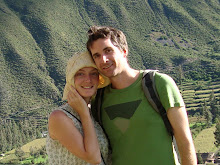An evening’s bus ride through the mountains from  Miners' statue in the workers district of Potosi
Miners' statue in the workers district of Potosi
The city was founded by the Spanish in the 16th century and quickly became one of the richest cities in the world. In the 17th century, it was comparable in size to  Cerro Rico mountain and the workers district.
Cerro Rico mountain and the workers district.
Most of the silver is long gone, along with it, incredibly and awfully, over 8 million people who lost their lives over the centuries mining the mountain in slave-like conditions. People continue to mine it although in far fewer numbers and with lesser results. Today they mainly extract zinc and copper which in the economic crisis have fallen significantly in price. A year ago, 21,000 people were working in the mines, but now there are only 7,000. The rest have had to leave the city to look for work in the countryside or in neighbouring countries.
Brass bands dominate the social scene on the streets in  Colonial centre
Colonial centre
The city is divided into the old colonial centre, full of grand churches and squares, and the old indigenous workers’ quarters full of ramshackle houses and winding streets heading up to the mountains.  Splendid hand-painted advertising on the sides of shops
Splendid hand-painted advertising on the sides of shops
We spent our first night in a dirty, tired hostel and I woke up with flea/bedbug bites. As it was my birthday the next day, we decided there couldn’t be a better time to splash out, and so we upped sticks to the best hotel in town (the equivalent of £30 for both of us) with a bath – it was so lovely, only the second place with a bath and hot water combination since we arrived in South America and the first with both of these and a plug. I was very happy. 
 A cafe advertising a view point. It turned out to be the roof of an old church overlooking the town square.
A cafe advertising a view point. It turned out to be the roof of an old church overlooking the town square.  We enjoyed a nice corn soup and fruit juices up on the roof.
We enjoyed a nice corn soup and fruit juices up on the roof.
Most travellers come to Potosí to go on a tour of the mines. I was a bit unsure about this as I had thought I might panic going down narrow, dusty tunnels with little air. We had another option of natural thermal baths. I decided to opt for the latter, but then after bumping into a guide who had been working in the mines since the age of 9, coming down from our panoramic tea on an old church roof, intrigue overcame fear and I opted to spend my birthday morning down the mine. We had a delicious meal in the evening in a fantastic converted industrial building and I tried llama for the first time which was tender and yummy. The ‘Mountain of Riches’ is visible from anywhere in Potosí and serves as a constant reminder of its dramatic history and people’s ongoing struggles. Its streets and markets are full of life and it was a fascinating place to spend a few days.
The ‘Mountain of Riches’ is visible from anywhere in Potosí and serves as a constant reminder of its dramatic history and people’s ongoing struggles. Its streets and markets are full of life and it was a fascinating place to spend a few days.  A colourful little square with unusual seats.
A colourful little square with unusual seats.

No comments:
Post a Comment